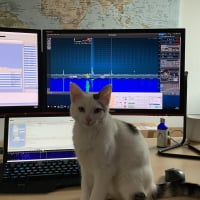Welcome to the FlexRadio Community! Please review the new Community Rules and other important new Community information on the Message Board.
Need the latest SmartSDR or 4O3A Genius Product Software?
SmartSDR v4.1.3 | SmartSDR v4.1.3 Release Notes
SmartSDR v3.10.15 | SmartSDR v3.10.15 Release Notes
The latest 4O3A Genius Product Software and Firmware
SmartSDR v4.1.3 | SmartSDR v4.1.3 Release Notes
SmartSDR v3.10.15 | SmartSDR v3.10.15 Release Notes
The latest 4O3A Genius Product Software and Firmware
If you are having a problem, please refer to the product documentation or check the Help Center for known solutions.
Need technical support from FlexRadio? It's as simple as Creating a HelpDesk ticket.
Need technical support from FlexRadio? It's as simple as Creating a HelpDesk ticket.
Audio crackle and Pops in Remote Operation Receive Lost Packets ???? Any Ideas Why ???
mikeatthebeach .
Member ✭✭
Using Remote operation of my Flex6600m via WAN the Receiver Audio has Crackles and Pops On both my iPad and iPhone using the FlexRadio IOS App from Marcus Notice no crackle and pops in Transmit Audio Is the Transmit Audio Packets processed differently than Receive Audio Packets Using Version 2.49 on the Flex6600 here Is the buffering or lack of buffering causing the lost Packets to cause the Crackles and Pops Does Buffering affect the Latency in the Receive Audio and can this be adjusted???? Can adjusting the MTU from 1500 to a different number relieve this problem? At the Server End where my Flex6600m is located using DSL with a 2Mbytes download and 0.3Kbytes upload speed, planning later to go to Fiber FIOS but on Vacation using the Remote I have check the boxes in the IOS App for low bandwidth connections, eliminated Waterfall and reduced Rate and FPS to near zero Sometimes it is ok in Rx Audio other times it is terrible with Receive Audio Crackle and Pops Any thoughts about Packet Sizes versus latency to avoid this on slow DSL connections?? Any one out there had similar issues and what have you done to fix it?
0
Answers
-
300kb/sec upload is about the limit of upload.
If that is all the upload available, then you want to make sure that you have your FPS reduced to about 0 and the same for the Rate setting in the display parameters. It sounds like you have that under control.
The pops are from packet loss, and possibly some buffer issues.
About the only fix at this point is to upgrade to Fiber when you can.
The reason you have no TX issues is that the TX is part of your 2mb/sec download at the radio end. This is to be expected.
Mike
1 -
Mike-at-the-beach, I remembered seeing this in the 2.5.0 Release Notes:
"Adjustable MTU for enhanced SmartLink Compatibility: Internet connections that utilize PPPoE (Point-to-Point Protocol over Ethernet), specifically DSL connections, cannot use the maximum 1500 byte packet size for communication over the Internet. This can result in issues with establishing a SmartLink connection. SmartSDR v2.5.0 provides a new feature where the MTU of the VITA-49 data can be set to a lower value to mitigate MTU related issues. (#7089) "
Looks like it has been noted and addressed, but I don't believe 2.5.0 has been released yet so its not yet available to us. My understanding is the the new 3.0 version will be further debugged and solutions devised, then appropriate changes will be rolled backward into the older 2.4.9 code to produce version 2.5.0. It doesn't seem like that will happen while you're still on vacation. Warren - K6WKW0 -
Warren I also have the latest Version 3 that available But have not played to much with it I do have TeamViewer and if a later version Becomes available to adjust the MTU Value In SDR IOS the MTU default is 1500 and changing that had no affect in The crackle and pop from lost packets So if Version 2.5 or possibly an Upgraded V3 will address this Issue Thanks Mike0
-
I have heard that the Even Route "IQ" router solves the "buffer bloat" issue
https://smile.amazon.com/IQrouter-Self-Optimizing-router-improved-quality/dp/B06WP5GTS8/ref=sr_1_1?keywords=even+router+iqrouter&qid=1559993513&s=gateway&sr=8-1
I'm going to get one and try and see if it helps with my dropped packets or high jitter which results in chopped audio - even though my ISP speeds are 25 Mbs down and 4 up (but it falls off as the day progresses - to the point of "poor" network conditions under Network in my Flex 6600M.
If you get the higher speeds fiber affords, then your problems (I have the same issues) will likely disappear.
I'm also waiting for Ver 3.0.24 to come out next week so I can adjust down the MTU - since I also have a trapazoid picture on my Maestro where there should be a display and waterfall.1 -
Yes I hope Flex allows adjustments to MTU And slight buffering can occur to prevent Chopped Audio The Buffering will cause some Latency But at least that may help than listening To garbled chopped incoherent audio!! Also got the Maestro with the Flex6600 Here Flex please take note !! 73 Mike0
-
If Flex could put the Brains of the IQ Router Into their software it would be great 73 Mike0
-
When running at my recently vacated location with 600 Kbps service, I found it necessary to turn Waterfall rate down to 0, and display FPS to between 5-9, and turn DAX off in order to get it to play. At 300 kbps you may need to run FPS even lower. There just isn’t much bandwidth to work with on your rig’s upload. Ken - NM9P0
-
Btw, on the iOS app, if you just click the “no waterfall” button, but don’t manually turn the Waterfall rate down to zero, you will still have bandwidth being used. I always manually turn the rate down , too.0
-
How do you know what to set the MTU to? Most packets require multiples of data like pixel pairs and padding etc. Breaking data groups between packets is a bad idea and should be avoided. What is recommended by Flex?0
-
It doesn’t really matter what the MTU is set to (within reason - you don’t want a bunch of really small frames) - you just want the size set to a low enough value that the network elements in the way (router, or whatever) won’t mess with fragmenting (or worse, dropping) the frames coming in. The network stack will take care of reassembling the data from incoming frames into a contiguous byte stream for the application consuming it. I suppose if you break data elements there may be a bit more effect if a frame is lost, but a lost frame will cause more trouble than just losing part of a data element split between frames. That’s my take on the whole MTU thing - if network equipment worked right, it just would not matter unless performance was already marginal.0
-
Hi Ted, I’ve done a few VOIP designs in firmware and video lines must be handled with care. Hopefully Flex lets you enter any value, then uses formulae under the hood to ensure legal splits without causing visual corruption. I suppose they are at both sides of the link so standard rules can be broken. Let’s hope the network gear in between is just as forgiving.0
-
I agree completely about video streams, Douglas. In a past life I worked in video delivery over IP - it’s all about buffering, and if you need minimal latency, it’s tough to deliver a clean stream without total network integrity (including constant latency). That said, the data stream between a Flex radio and the computer running the SSDR software is not video - it is data describing the spectrum and waterfall, plus audio streams, with embedded timestamps. Latency is important, but it is not fatal to have a fixed several hundred milliseconds of delay, thus allowing for some considerable buffering. I believe that Flex could possibly do a better job of managing buffers (at the occasional expense of a bit more delay, preferably configurable). Given a bit of buffering, the network stack reassembly capability will look after any fragmentation of data between packets - as long as none, or few, are lost. Here’s hoping Flex continues to address smooth delivery of data and audio for remoting in diverse network environments.1
-
True, packet loss is crucial while latency can be up to ~400ms before it gets critical. Packet loss of more than 0.2% leads to audio drops.
0 -
I am having lost packets when using the Power Genius Amp. I am operating locally with Maestro-C, 6400, PG, TG. With amp in Standby transmit audio is clear. With amp on, audio is chopped up and lost packets are counting during transmission. I have added ferrite chokes on all cat5 cables but problem remains. Any suggestions?0
-
There are more current discussions regarding this and working to find the packet loss you are experiencing. This is a 4 year old posting.
The first suggestion I always say to try is to not use a 1Gb switch and use a 100Mb switch and see if that helps, as well as use good quality LAN cables.
0 -
My experience with switches tracks Mikes comment above. I used an older router/WAP, disabled the WiFi, and use it as a switch locally. Works well.
0
Leave a Comment
Categories
- All Categories
- 381 Community Topics
- 2.1K New Ideas
- 631 The Flea Market
- 8.3K Software
- 123 SmartSDR+
- 6.4K SmartSDR for Windows
- 184 SmartSDR for Maestro and M models
- 430 SmartSDR for Mac
- 272 SmartSDR for iOS
- 259 SmartSDR CAT
- 195 DAX
- 382 SmartSDR API
- 9.3K Radios and Accessories
- 39 Aurora
- 265 FLEX-8000 Signature Series
- 7.2K FLEX-6000 Signature Series
- 950 Maestro
- 56 FlexControl
- 866 FLEX Series (Legacy) Radios
- 925 Genius Products
- 463 Power Genius XL Amplifier
- 337 Tuner Genius XL
- 125 Antenna Genius
- 297 Shack Infrastructure
- 209 Networking
- 460 Remote Operation (SmartLink)
- 144 Contesting
- 788 Peripherals & Station Integration
- 139 Amateur Radio Interests
- 1K Third-Party Software




